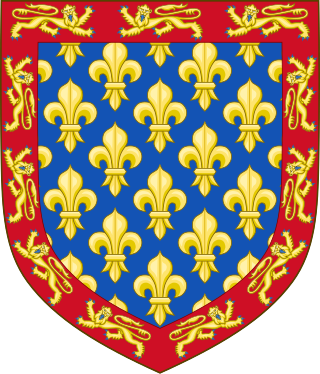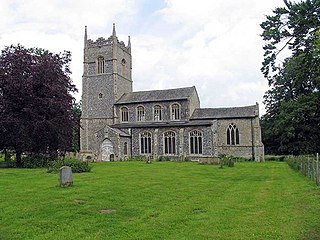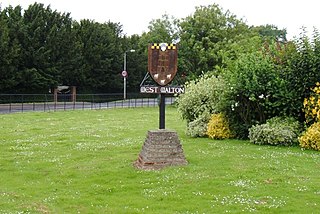Related Research Articles

Roger de Montgomery, also known as Roger the Great, was the first Earl of Shrewsbury, and Earl of Arundel, in Sussex. His father was Roger de Montgomery, seigneur of Montgomery, a member of the House of Montgomery, and was probably a grandnephew of the Duchess Gunnor, wife of Duke Richard I of Normandy, the great-grandfather of William the Conqueror. The elder Roger had large landholdings in central Normandy, chiefly in the valley of the River Dives, which the younger Roger inherited.

Hamelin de Warenne, Earl of Surrey, was an Anglo-Angevin nobleman, being an elder half-brother of the first Plantagenet English monarch King Henry II.

William de Warenne, 2nd Earl of Surrey was the son of William de Warenne, 1st Earl of Surrey and his first wife Gundred. He was more often referred to as Earl Warenne or Earl of Warenne than as Earl of Surrey.
William de Warenne, 3rd Earl of Surrey was an Anglo-Norman nobleman, member of the House of Warenne, who fought in England during the Anarchy and generally remained loyal to King Stephen. He participated in, and ultimately perished during, the Second Crusade.
Gundred or Gundreda was the Flemish-born wife of an early Norman baron, William de Warenne, 1st Earl of Surrey. She and her husband established Lewes Priory in Sussex.
Elizabeth of Vermandois, was a French noblewoman, who by her two marriages was the mother of the 1st Earl of Worcester, the 2nd Earl of Leicester, the 3rd Earl of Surrey, and of Gundred de Warenne, mother of the 4th Earl of Warwick.

Toftrees is a village and former civil parish, now in the parish of Dunton, in the North Norfolk district, in the county of Norfolk, England. The hamlet is 2.3 miles south west of Fakenham, 27.3 miles north west of Norwich and 113 miles north north east of London. The nearest railway station is at Sheringham for the Bittern Line which runs between Sheringham, Cromer and Norwich. The nearest airport is Norwich International Airport. The village is situated on the north west side of the A1065 Fakenham to Swaffham road. In 1931 the parish had a population of 72.

Illington is a village and former civil parish, now in the parish of Wretham in the Breckland district, in the county of Norfolk, England. The village is 6.2 miles north east of Thetford, 24 miles west south west of Norwich and 92.3 miles north east of London. The nearest railway station is at Thetford for the Breckland Line which runs between Cambridge and Norwich. The nearest airport is Norwich International Airport. In 1931 the parish had a population of 53. On 1 April 1935 the parish was abolished to form Wretham.

Little Snoring is a village and a civil parish in Norfolk, England.

Plumstead is a village and a civil parish in the English county of Norfolk. The village is 19.7 miles (31.7 km) north north west of Norwich, 9.5 miles (15.3 km) south-west of Cromer and 134 miles (216 km) north-east of London. The nearest town is Holt which is 4.8 miles (7.7 km) to the north west of the village. The nearest railway station is in the town of Sheringham where access to the national rail network can be made via the Bittern Line to Norwich. The nearest airport is Norwich International Airport. Plumstead falls within the area covered by North Norfolk District Council.

Knapton is a village and a civil parish in the English county of Norfolk. The village is 8.9 miles (14.3 km) southeast of Cromer, 19.4 miles (31.2 km) northeast of Norwich and 134 miles (216 km) northeast of London. The Village is located alongside the B1145 a route which runs between King's Lynn and Mundesley. The nearest railway station is at North Walsham for the Bittern Line which runs between Sheringham, Cromer and Norwich. The nearest airport is Norwich International Airport.
Nigel d'Aubigny, was a Norman Lord and English baron who was the son of Roger d'Aubigny and Amice or Avice de Mowbray. His paternal uncle William was lord of Aubigny, while his father was an avid supporter of Henry I of England. His brother William d'Aubigny Pincerna was the king's Butler and father of the 1st Earl of Arundel. He was the founder of the noble House of Mowbray.
Isabel de Warenne, 4th Countess of Surrey was an English peer. She was the only surviving heir of William de Warenne, 3rd Earl of Surrey, and his wife, Adela, the daughter of William III of Ponthieu.

Little Barningham is a village and a civil parish in the English county of Norfolk. The village is 19 miles (31 km) north of Norwich, 10 miles (16 km) south-west of Cromer and 133 miles (214 km) north-east of London. The nearest railway station is in the town of Sheringham where access to the national rail network can be made via the Bittern Line to Norwich. The nearest airport is Norwich International Airport. Little Barningham is within the area covered by North Norfolk District Council.

Hilborough is a village and a civil parish in the English county of Norfolk. The village is 5.5 miles (8.9 km) south of Swaffham, 25.4 miles (40.9 km) west-southwest of Norwich and 93.2 miles (150.0 km) north-northeast of London.

Little Ellingham is a village and civil parish in the English county of Norfolk. The village is 4.6 miles (7.4 km) north-west of Attleborough, 2 miles (3.2 km) north-west of its sister village of Great Ellingham, 18.8 miles (30.3 km) west-south-west of Norwich and 105 miles (169 km) north-east of London. The nearest railway station is at Attleborough for the Breckland Line which runs between Cambridge and Norwich. The nearest airport is Norwich International Airport.

Outwell is a village and civil parish in the borough of King's Lynn and West Norfolk, in the English county of Norfolk.

West Walton is a village and civil parish in the King's Lynn and West Norfolk District of Norfolk, England.

Gerbod the Fleming, of Oosterzele, 1st Earl of Chester, was a hereditary advocate of the Abbey of Saint Bertin at Saint-Omer, County of Flanders and Earl of Chester in 1070.

The de Warenne family were a noble family in England that included the first Earls of Surrey, created by William the Conqueror in 1088 for William de Warenne, 1st Earl of Surrey, who was among his companions at the Battle of Hastings. The family originated in Normandy and, as Earls, held land there and throughout England. When the senior male-line ended in the mid-12th century, the descendants of their heiress adopted the Warenne surname and continue as Earls of Surrey for another two centuries. Several junior lines also held land or prominent offices in England and Normandy.
References
- ↑ Lewis, C. P. "Warenne, William (I) de, first earl of Surrey (d. 1088)". Oxford Dictionary of National Biography (online ed.). Oxford University Press. doi:10.1093/ref:odnb/28736.(Subscription or UK public library membership required.)
- 1 2 3 4 K. S. B. Keats-Rohan, "Aspects of Torigny's Genealogy Revisited", Nottingham Medieval Studies 37:21–27
- ↑ Lewis C. Loyd, "The Origins of the Family of Warenne", Yorkshire Archaeological Journal, 31:97–113.
- ↑ Thomas Stapleton, "Observations in disapproval of a pretended marriage of William de Warren, Earl of Surrey, with a daughter... of William the Conqueror", Archaeological Journal, 3:1–12.
- 1 2 G. H. White, "The Sisters and Nieces of Gunnor, Duchess of Normandy", Genealogist, n. s. 37:57–65.
- ↑ Eleanor Searle, Predatory Kinship and the Creation of Norman Power, 840–1066, pp. 100–105.
- ↑ Elisabeth M. C. van Houts, "Robert of Torigni as Genealogist", Studies in Medieval History presented to R. Allen Brown, pp. 215–233.
- ↑ Kathleen Thompson, "The Norman Aristocracy before 1066: the Example of the Montgomerys", Historical Research 60:251–263.
- ↑ K. S. B. Keats-Rohan, Domesday People, a Prosopography of Persons Occurring in English Documents 1066–1166 (Woodbridge: The Boydell Press, 1999), p. 480.
- ↑ Lewis C. Loyd, The Origins of Some Anglo-Norman Families, ed. Charles Travis Clay (Baltimore: Genealogical Publishing Co., 1992) pp. 111–112.
- ↑ G. E. Cokayne, The Complete Peerage, Vol. XII/1 (London: The St. Catherine Press, 1953), p. 491.
- ↑ David C. Douglas, William the Conqueror (Berkeley; Los Angeles: University of California Press, 1964), p. 100.
- 1 2 3 G. E. Cokayne, The Complete Peerage, Vol. XII/1 (London: The St. Catherine Press, 1953), p. 493.
- 1 2 William Farrer, Early Yorkshire Charters, Volume VIII; The Honour of Warenne (The Yorkshire Archaeological Society, 1949), p. 3.
- ↑ Elisabeth M. C. van Houts, "The Ship List of William the Conqueror",Anglo-Norman Studies X; Proceedings of the Battle Conference 1987, ed. R. Allen Brown (Woodbridge: Boydell Press, 1988), pp. 159 and 161.
- ↑ The Gesta Guillelmi of William of Poitiers, ed. and trans. R. H. C. Davis and Marjorie Chibnall (New York: Oxford University Press, 1998), pp. 134–135.
- ↑ G. E. Cokayne, The Complete Peerage, Vol. XII/1 (London: The St. Catherine Press, 1953), Appendix L, "Companions of the Conqueror", pp. 47–48.
- ↑ A. Duchesne, Historiae Normannorum Scriptores Antiqui (Lutetiae Parisiorum 1619), pp. 202 and 204 (one of 12 nobles named by William of Poitiers).
- 1 2 William Hunt (1899). . In Lee, Sidney (ed.). Dictionary of National Biography . Vol. 59. London: Smith, Elder & Co. pp. 372–373.
- ↑ Elisabeth van Houts, "Frederick, Brother-in-Law of William of Warenne", Anglo-Saxon England, New York, Vol. 28 (1999), p. 218.
- ↑ Appleby, Outlaws in Medieval and Early Modern England (2009), pp. 28–29.
- ↑ William Farrer; Charles Travis Clay, Early Yorkshire Charters, Volume VIII; The Honour of Warenne (The Yorkshire Archaeological Society, 1949), p. 4.
- ↑ Brian Golding, "The Coming of the Cluniacs", Anglo-Norman Studies III; Proceedings of the Battle Conference 1980, Vol. III ( Woodbridge: Boydell Press, 1981), pp. 65 and 67.
- ↑ William Farrer; Charles Travis Clay, Early Yorkshire Charters, Vol. VIII; The Honour of Warenne (The Yorkshire Archaeological Society, 1949), pp. 50–55.
- ↑ David Knowles, The Monastic Order in England, 2nd ed. (Cambridge University Press, 1966), pp. 151–152.
- ↑ C. P. Lewis, "The Earldom of Surrey and the Date of the Domesday Book", Historical Research; The Bulletin of the Institute of Historical Research, vol. 63, no. 152 (October 1990), p. 335 (between the end of 1087 and 24 March 1088).
- ↑ G. E. Cokayne, The Complete Peerage, vol. xii/1 (St. Catherine Press, London, 1953), pp. 494–495.
- ↑ Hyde Abbey, Liber Monasterii de Hyda: Comprising a Chronicle of the affairs of England, ed. Edward Edwards (Longmans, Green, Reader, and Dyer, London, 1866), p. 299.
- ↑ G. E. Cokayne, The Complete Peerage, vol. iv (St. Catherine Press, London, 1916), p. 670.
- ↑ David C. Douglas, William The Conqueror (University of California Press, Berkeley and Los Angeles, 1964) pp. 267 and 392.
- ↑ Elisabeth van Houts, 'Frederick, Brother-in-Law of William of Warenne', Anglo-Saxon England, Vol. 28 (1999), pp. 218–220.
- ↑ G. E. Cokayne, The Complete Peerage, vol. xii/1 (St. Catherine Press, London, 1953), p. 494 and note (l).
- ↑ G. E. Cokayne, The Complete Peerage, vol. xii/1 (The St. Catherine Press, London, 1953), pp. 495–496.
- 1 2 G. E. Cokayne, The Complete Peerage, vol. xii/1 (The St. Catherine Press, London, 1953), p. 494 and note (b).
- ↑ Detlev Schwennicke, Europäische Stammtafeln: Stammtafeln zur Geschichte der Europäischen Staaten , Neue Folge, Band III Teilband 4 (Marburg, Germany: J. A. Stargardt, 1989), Tafel 699.
- ↑ K. S. B. Keats-Rohan, Domesday Descendants: A Prosopography of Persons Occurring in English Documents 1066–1166, Vol. II (UK, Rochester, NY: Boydell & Brewer, 2002), p. 408.
- 1 2 3 4 5 6 7 8 9 10 11 The Domesday Book: England's Heritage Then and Now, ed. Thomas Hinde (UK: Coombe Books, 1996), p. 186
- 1 2 3 4 5 6 7 The Domesday Book: England's Heritage Then and Now, ed. Thomas Hinde (UK: Coombe Books, 1996), p. 187.
- 1 2 The Domesday Book: England's Heritage Then and Now, ed. Thomas Hinde (UK: Coombe Books, 1996), p. 47.
- 1 2 3 4 5 6 7 8 9 10 11 12 13 The Domesday Book: England's Heritage Then and Now, ed. Thomas Hinde (UK: Coombe Books, 1996), p. 188.
- 1 2 3 4 5 6 7 8 9 10 11 12 13 14 15 The Domesday Book: England's Heritage Then and Now, ed. Thomas Hinde (UK: Coombe Books, 1996), p. 189.
- 1 2 3 4 5 6 7 8 9 10 11 12 13 The Domesday Book: England's Heritage Then and Now, ed. Thomas Hinde (UK: Coombe Books, 1996), p. 190.
- 1 2 3 4 5 6 7 8 9 10 11 12 13 14 15 The Domesday Book: England's Heritage Then and Now, ed. Thomas Hinde (UK: Coombe Books, 1996), p. 191.
- 1 2 3 4 5 6 The Domesday Book: England's Heritage Then and Now, ed. Thomas Hinde (UK: Coombe Books, 1996), p. 48.
- 1 2 3 4 5 6 7 8 9 10 11 12 13 14 15 The Domesday Book: England's Heritage Then and Now, ed. Thomas Hinde (UK: Coombe Books, 1996), p. 192.
- 1 2 3 4 5 6 7 8 9 10 11 12 The Domesday Book: England's Heritage Then and Now, ed. Thomas Hinde (UK: Coombe Books, 1996), p. 193.
- 1 2 3 4 5 6 7 8 9 10 11 12 13 14 The Domesday Book: England's Heritage Then and Now, ed. Thomas Hinde (UK: Coombe Books, 1996), p. 194.
- 1 2 3 4 5 6 7 8 9 10 11 12 The Domesday Book: England's Heritage Then and Now, ed. Thomas Hinde (UK: Coombe Books, 1996), p. 195.
- 1 2 3 4 5 6 7 8 9 10 11 12 The Domesday Book: England's Heritage Then and Now, ed. Thomas Hinde (UK: Coombe Books, 1996), p. 196.